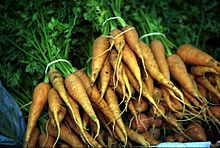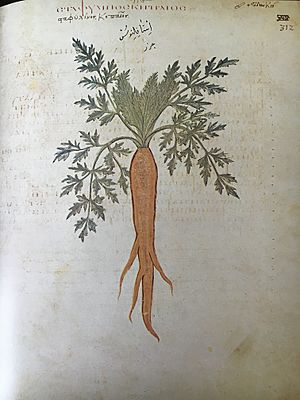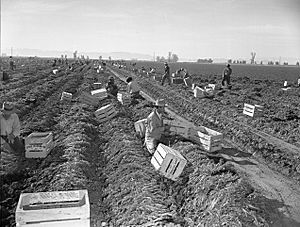Carrot facts for kids
Quick facts for kids Carrot |
|
|---|---|
 |
|
| Harvested carrots | |
| Scientific classification | |
| Kingdom: | |
| Division: | |
| Class: | |
| Order: | |
| Family: | |
| Genus: |
Daucus
|
| Binomial name | |
| Daucus carota |
|
The carrot (Daucus carota subsp. sativus) is a root vegetable that you probably know for its bright orange color! But did you know carrots can also be purple, black, red, white, or yellow? Carrots are a type of wild carrot that people have grown and changed over many years. Wild carrots originally came from Europe and a part of Asia called southwestern Asia.
Scientists believe carrots first grew in a place called Persia (which is now Iran and Afghanistan). People first grew them for their leaves and seeds, not for the root we eat today. The part of the carrot plant we usually eat is the long, thick root that grows underground. Over time, people chose to grow carrots that had bigger, sweeter, and less woody roots.
Carrots are a biennial plant, which means they take two years to complete their life cycle. In the first year, the plant grows a bunch of leaves and builds up its big root. Some types of carrots grow very fast and are ready to pick in about three months (90 days). Others take a bit longer, about four months (120 days). Carrots are full of good stuff like alpha- and beta-carotene, which your body turns into vitamin A. They also have vitamin K and vitamin B6. You might have heard that eating carrots helps you see better in the dark. This is actually a myth! It was a trick used by the British during World War II to fool their enemies.
The Food and Agriculture Organization (FAO) says that in 2013, about 37.2 million tonnes of carrots and turnips were grown around the world. Almost half of all carrots (about 45%) came from China! Carrots are used in so many different kinds of food, especially in salads. Carrot salads are a popular dish in many places.
Contents
What's in a Name?
The word "carrot" first appeared in English around the year 1530. It came from the French word carotte, which came from the Latin word carōta. This word can be traced back to an old language root that meant "horn," probably because of the carrot's horn-like shape. Long ago, in Old English, people didn't always tell the difference between carrots (which were often white then) and parsnips. They called both of them moru or more.
In some languages today, the word for "carrot" is the same as the word for "root." For example, in Dutch, the word for carrot is wortel, which also means "root."
A Brief History of Carrots
Scientists who study genes and old writings believe that all the carrots we eat today came from one single place in Central Asia. The wild ancestors of the carrot likely grew in Persia (parts of which are now Iran and Afghanistan). This area is still home to many different kinds of wild carrots. Over hundreds of years, people carefully chose and grew wild carrots that were less bitter, sweeter, and had a softer middle. This is how we got the familiar garden carrot we know today.
When carrots were first grown, people were more interested in their fragrant leaves and seeds than their roots. Carrot seeds have been found in Switzerland and Southern Germany that are 4,000 to 5,000 years old! Some plants that are related to carrots are still grown for their leaves and seeds today, like parsley, cilantro, fennel, dill, and cumin. The first time the carrot root was mentioned in old writings was around the 1st century AD. It's possible the Romans ate carrot roots, but it's a bit unclear because they used the same word, pastinaca, for both carrots and parsnips.
A very old book called the Juliana Anicia Codex, made in 515 AD, shows and describes carrots. This book is a copy of a Greek doctor's book about herbs and medicines from the 1st century AD. It shows three different kinds of carrots, and the old Greek text says that "the root can be cooked and eaten."
Carrots seem to have arrived in Spain around the 8th century, brought by the Moors. In the 10th century, carrots grown in places like West Asia, India, and Europe were mostly purple. The modern carrot we eat today probably came from Afghanistan around this time. An old Jewish scholar in the 11th century wrote about both red and yellow carrots. By the 14th century, cultivated carrots were in China, and by the 18th century, they were in Japan.
The orange-colored carrots we see most often appeared in the Netherlands in the 17th century. Some people think this was because the Dutch flag at that time, the Prince's Flag, had orange in it. European settlers brought carrots to colonial America in the 17th century.
Even today, you can sometimes find purple carrots that are still orange inside! These were first sold in British stores in 2002.
How Carrots Grow
Carrots grow from tiny seeds. While some types can take up to four months (120 days) to be ready, most carrots are ready to harvest in about 70 to 80 days if they have good growing conditions. Carrots grow best in full sunshine but can handle a little bit of shade. The best temperature for them is between 16 to 21 degrees Celsius (61 to 70 degrees Fahrenheit).
The perfect soil for carrots is deep, loose, and drains water well. Sandy or loamy soil is best, with a pH level of 6.3 to 6.8. It's important not to use too much fertilizer, especially nitrogen, because carrots need low levels of nitrogen, a medium amount of phosphate, and a lot of potash. If the soil is too rich or rocky, the carrot roots might become hairy or grow into strange shapes. Growers water carrots when needed to keep the soil moist. After the tiny carrot plants sprout, they are thinned out so that each plant has about 3 to 4 inches (8 to 10 cm) of space. This helps them grow big and strong. Weeds are also removed so they don't compete with the carrots for water and nutrients.
Good Plant Neighbors
Carrots like to grow near plants that have strong smells. The strong scent of onions, leeks, and chives can help keep away a pest called the carrot root fly. Other vegetables that grow well with carrots include lettuce, tomatoes, and radishes. Herbs like rosemary and sage are also good neighbors. Carrots also do well when planted near caraway, coriander, chamomile, marigold, and Swan River daisy.
Carrots can also help other plants! If you let a carrot plant flower, it will attract helpful wasps. These wasps are good because they eat many common garden pests.
Eating Carrots
You can eat carrots in many different ways! When you eat raw carrots, your body only gets about 3% of the good stuff called beta-carotene. But if you cook them, mash them, and add a little cooking oil, your body can get up to 39% of the beta-carotene! You can chop and boil, fry, or steam carrots. They are often used in soups and stews, and even in baby food and pet food. A famous way to cut carrots is called carrots julienne, where they are cut into thin sticks. Carrots are also one of the main vegetables, along with onion and celery, used to make a mirepoix, which is a mix of vegetables used to flavor many dishes and broths.
Because carrots are naturally sweet, they can even be used in dishes that seem more like fruit. Grated carrots are a key ingredient in carrot cakes and carrot puddings. Carrots can also be used by themselves or mixed with fruits to make jams and preserves. Carrot juice is also very popular, especially as a healthy drink, either on its own or mixed with other fruit and vegetable juices.
If someone eats a huge amount of carrots for a long time, their skin might turn a little yellow or orange. This is called carotenemia and happens because of too much beta-carotene in the body. It's usually harmless.
The Night Vision Myth
You might have heard that eating carrots helps you see in the dark. This is a myth! The beta-carotene in carrots (which your body turns into vitamin A) only helps people see better in the dark if they don't have enough vitamin A to begin with.
This myth was actually propaganda used by the Royal Air Force during World War II. They wanted to explain why their pilots were so good at fighting at night. The real reason was that they had new radar technology and used special red lights on their airplane dashboards. But to keep these secrets, they told everyone that their pilots ate lots of carrots!
Even though it was a myth, the British government encouraged people to eat carrots as part of a "Dig for Victory" campaign. A radio show called The Kitchen Front taught people how to grow, store, and use carrots in new ways, like making carrot jam and a dish called Woolton pie.
Images for kids
-
Carrots for sale in a market in Ljubljana
See also
 In Spanish: Zanahoria para niños
In Spanish: Zanahoria para niños









